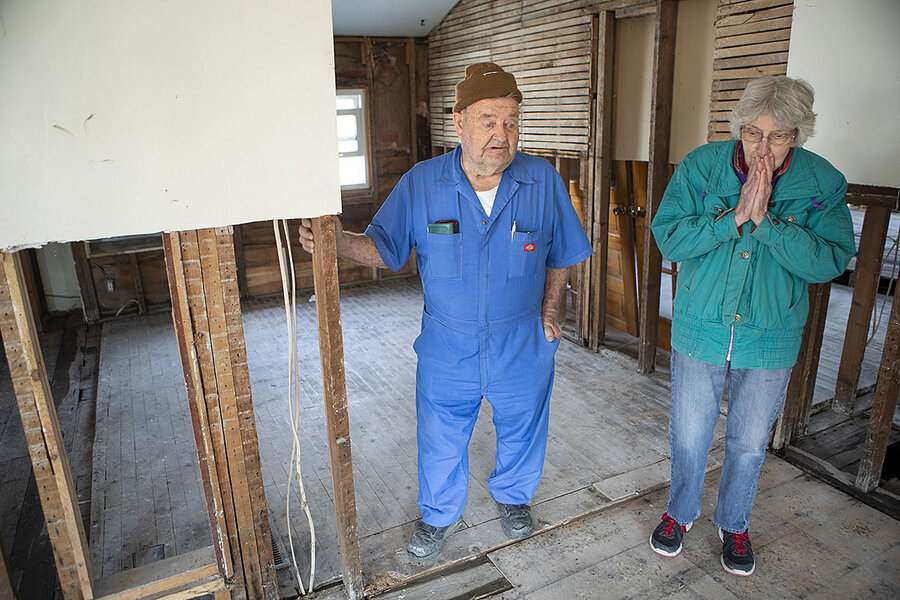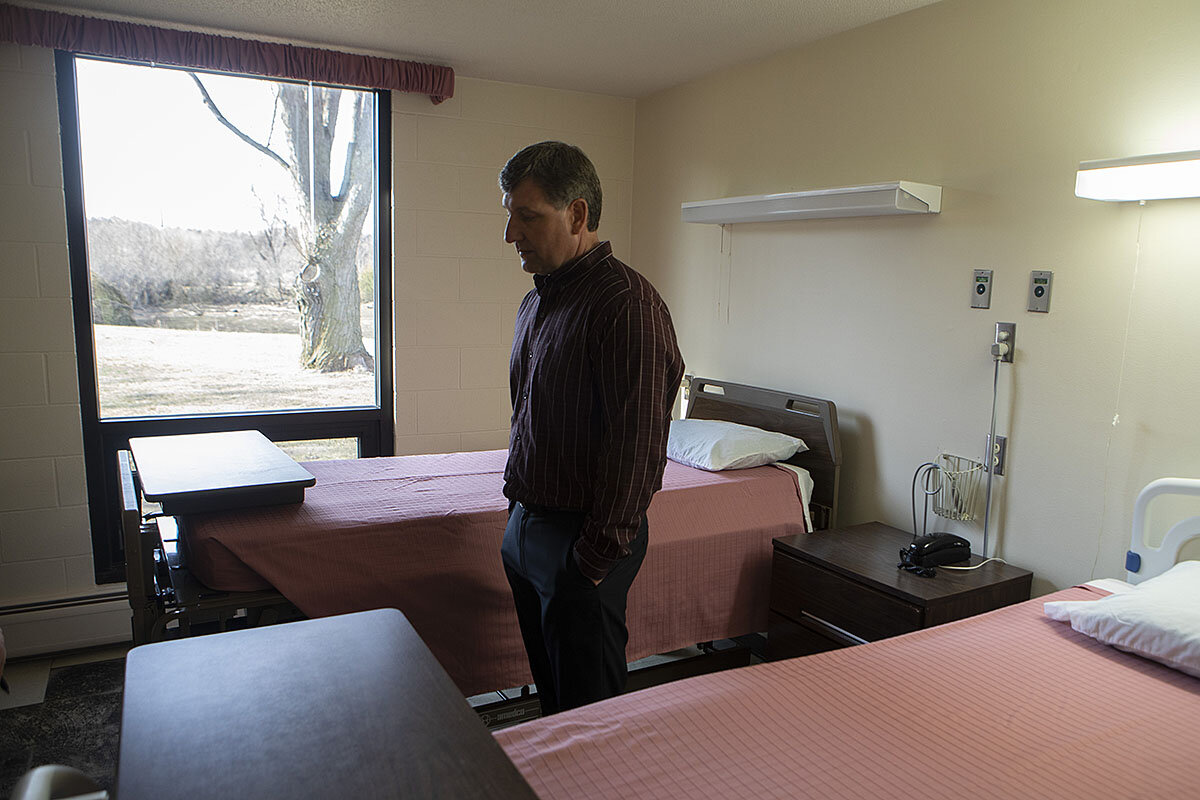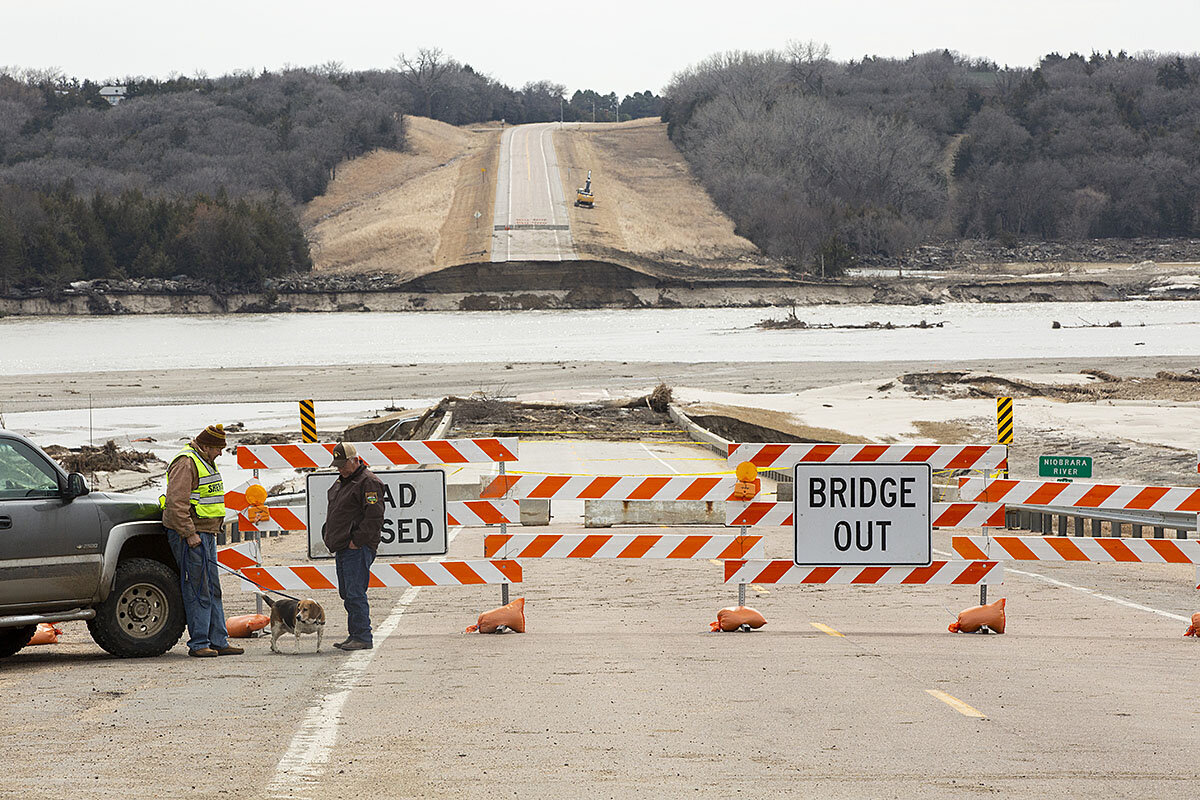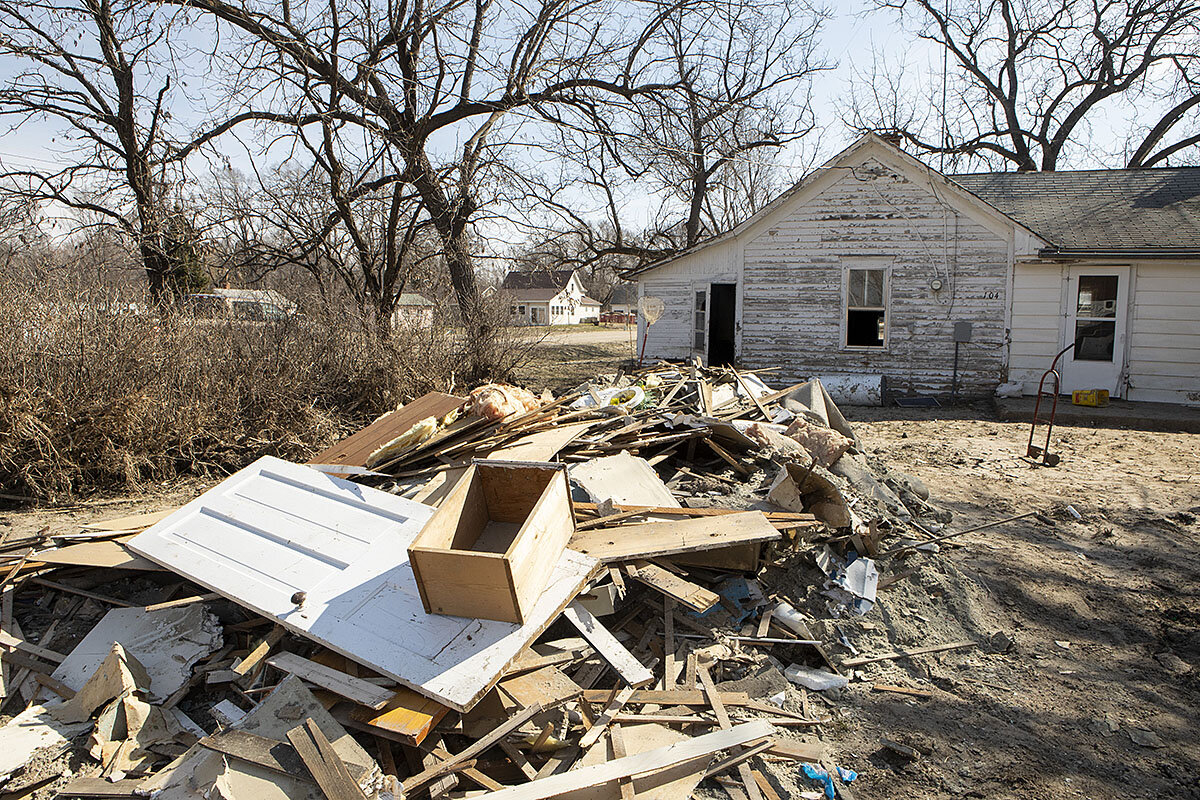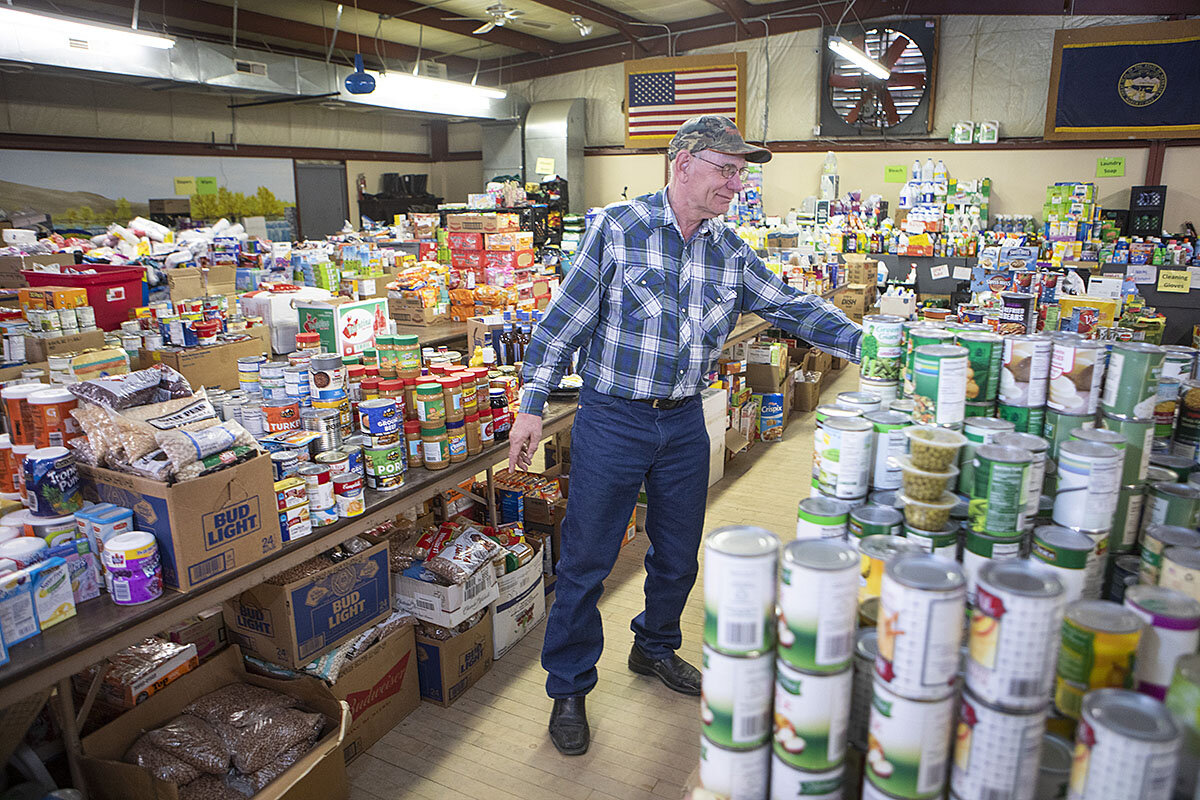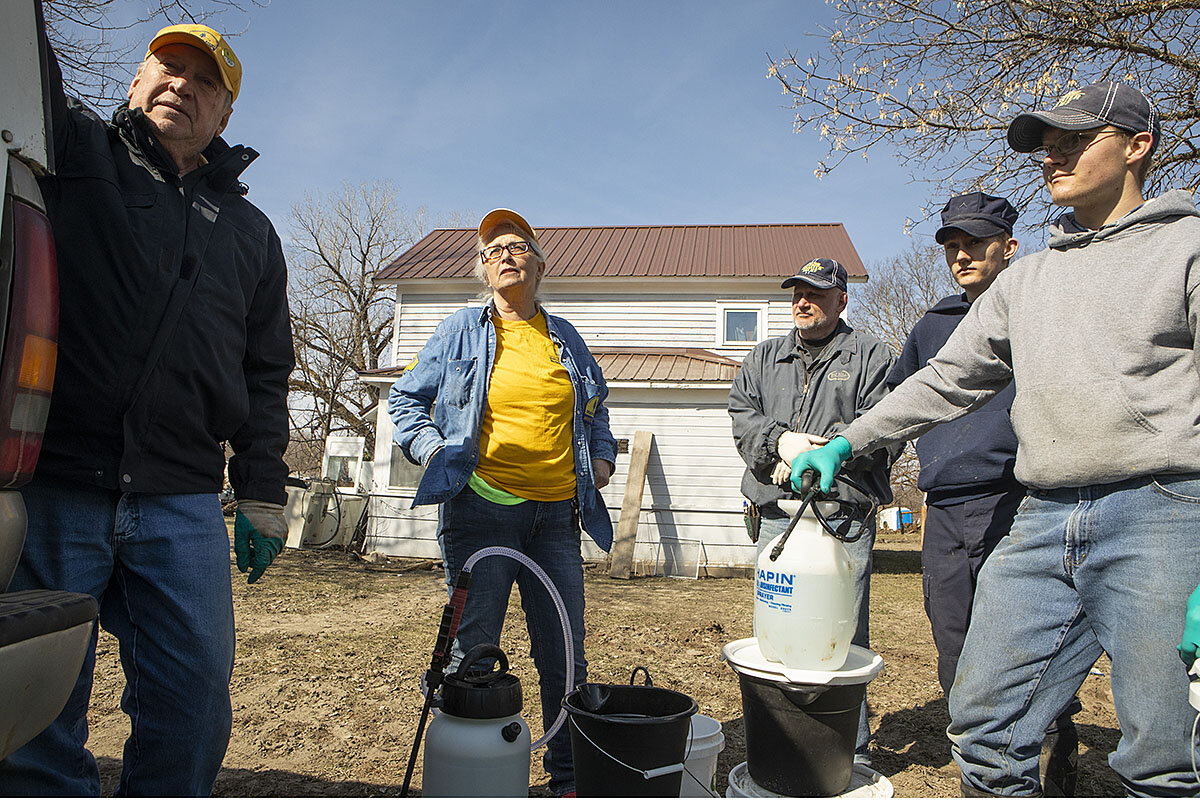When dam burst, here’s how one Nebraska town met the epic floods
Loading...
| Lynch, Neb.
Janice Halstead pulls an old photo, browned by the floodwaters, from a garage stuffed with furniture and hands it to her husband.
“Do you recognize that?”
“That’s our wedding,” says Larry Halstead of the 57-year-old portrait. He pitches the nearly undecipherable photo into the blue recycling cart he’s leaning on.
Why We Wrote This
Flooding is a perennial danger for people living along Great Plains watersheds. But this spring the challenge has been epic in scale, calling forth individual resilience and the bonds of community.
Three weeks ago, the couple barely made it out of their home before the fast-rising Ponca Creek flooded its banks and ran 4 feet of water through it. Now with no heat or working toilets in their house, and living with relatives, the retired couple faces the daunting task of picking through their belongings, which Mr. Halstead rates as an almost total loss. But there’s no complaint. Not even a tear.
“We’ll rebuild,” promises Mr. Halstead, former town mayor and until recently proprietor of the local TV and appliance store. It’s not clear yet just how. The home was too near the floodplain to qualify for federal flood insurance. But the Knights of Columbus and someone from out of town have donated a little money. “Everyone has been wonderful to us,” he says.
It’s a sentiment that reverberates around Lynch, Nebraska, a no-stoplight community with a pink town hall and 230 people, and one of the hardest-hit places in March’s epic flood, which inundated cities and wide swaths of farmland from Wisconsin to Nebraska and South Dakota to Missouri. This corner of the state is a microcosm of how Nebraskans have rallied in the face of the state’s most pervasive flooding in memory.
“I have never seen it come up this fast,” says Kelly Kalkowski, administrator of the Niobrara Valley Hospital, which sits a stone’s throw from Ponca Creek. On Wednesday, March 13, he ordered the discharge of those patients who could go home. One patient was sent to the nearest hospital, in O’Neill, some 40 miles away. At first, he thought the recently built berm would protect the hospital, so when the call came asking if he’d like some sand for sandbagging, he demurred. But the creek kept rising. An hour later, he ordered the sand.
“I felt like a mouse in a maze,” recalls Vance Janak, a Nebraskan with a rural mail route just across the border in South Dakota. The freakish combination of snow, rain, and a rapid snow melt on top of frozen ground kept forcing him to backtrack to find other ways to the houses on his route.
Also worried about flooded roads, Jane Nelson left her job early at Special T’s, a custom screen-printing and embroidery shop in Lynch. But when word came that the hospital needed help, Ms. Nelson, a volunteer emergency medical technician, turned around and headed there.
Steve Spencer, a Boyd County supervisor, also headed to the hospital with his frontloader, leaving behind his other heavy equipment, perilously close to the creek. In all, some 40 to 50 volunteers showed up to sandbag: first with gravel, then with sand when it was delivered around 7 p.m. Some of them were volunteer firefighters from as far away as O’Neill. It was a race against time to save the hospital.
Under the direction of Mr. Kalkowski and the volunteer fire chief, Jim McBride, they worked into the night, eventually erecting a barrier four sandbags high around all the entrances before the waters got too high. As a last resort, the frontloader dumped the rest of the sand on top of the sandbags before evacuating the volunteers across the flooded parking lot to Nebraska Highway 12, which cuts through town. The hospital was now its own island.
Ms. Nelson sandbagged until word came that Mr. McBride’s own house had been flooded. She and others moved there to see if they could help with rescues from homes at risk from the rising water. Finally, at around 2 or 3 in the morning, she got to sleep at a relative’s home as the roads out of Lynch were blocked, but was interrupted a couple of hours later with even worse news. The old hydroelectric dam near Spencer was compromised.
Without an emergency spillway, the 92-year-old dam had been holding back water and ice chunks the size of cars. Workers reportedly got some of the old wooden gates open to relieve the pressure, but some were frozen shut. When they realized that water was overtopping the earthen part of the dam, they evacuated, stopping to warn resident Kenny Angel, who did not evacuate with them. At 5:30 a.m. Thursday, county Sheriff Chuck Wrede got a call that the highway had been washed out. “It was snowing and blowing,” he recalls nearly three weeks later, surveying the scene. The rapid melt had been followed by two inches of rain and then a blizzard. “You couldn’t tell what was going on.”
By daylight, it began to come clear that the collapse of the dam had changed the course of the Niobrara River hundreds of yards to the south, turning a hayfield into its main channel and washing away a business, Mr. Angel’s home, motor homes, and a few vehicles. All their owners have been accounted for except Mr. Angel, presumed to be one of at least three fatalities in the Nebraska and Iowa floods. When the dam gave way, an estimated 11-foot wave swept down the river, heading for the town of Niobrara, where Mr. Janak’s parents were hoping to save what they could from their service station, Vic’s Service, which was already flooded nearly to its 10-foot ceiling. The wall of water swept away the service station just one month shy of its 25th anniversary. Three other businesses in the low-lying district also were heavily damaged.
The Niobrara River didn’t flood Lynch directly, but just south of the breached dam it washed away a portion of US 281, a major two-lane connection from Boyd County to neighboring Holt County to the south. And it destroyed the water pipe crossing the river that supplies Lynch and most of the rest of the county with drinking water.
By Thursday night, it looked like the water had hit its high mark in Lynch. So around 11, Mr. Kalkowski waded through the hip-deep waters in the parking lot to inspect the hospital. Water covered the floors in the patient rooms, but except for a few popped tiles, there was no damage. The hospital had been saved. By the following evening, staff and volunteers had cleaned up and opened the emergency room.
For Lynch’s volunteers, the first 48 hours were such a blur that there was little time to assess what had happened. “We didn’t know how bad it was,” recalls Ms. Nelson. But on Friday, as she began assessing the condition of people rescued by boat, the enormity of what Lynch had survived began to sink in. All the roads leading out of town were under water. Three of the four bridges connecting Boyd County with Holt County were out. There was no potable water. No one could flush toilets because the sewer system was clogged with sand. Some 60 houses had been flooded, roughly a third of the homes in town.
In all, 65 of Nebraska’s 93 counties, 74 cities, and four tribal areas would declare states of emergency. The following week, President Donald Trump would declare a state of emergency for both Nebraska and Iowa, freeing federal funds. Nebraska Gov. Pete Ricketts called it “the most widespread destruction we have ever seen in our state’s history.”
Lynch had little time to catch its breath. To coordinate rescue and recovery operations, Ms. Nelson and the fire chief’s wife, Mindy McBride, organized a command center at the volunteer fire department. Volunteers going on rescue missions checked in. People in need called with requests. So did volunteers with something to give. In the ensuing days, outside help began to pour in.
“It just came in waves,” says one of two volunteers at the Lynch Community Center, where tables of donated goods are piled up, from cans of food on tables to bleach and gloves and buckets around the sides. One of the first trucks to arrive was from Orphan Grain Train, a nonprofit volunteer network based in Norfolk, which delivered 40 pallets of bottled drinking water to Spencer and Lynch. Someone delivered portable toilets.
“It’s amazing the things people thought of donating,” says Ms. Nelson, who still gets choked up thinking about the underwear, cleaning supplies, gloves, and other donations the community received. Students at Skyview Learning Academy, an elementary school run by Seventh-day Adventists in Douglas put flyers under windshields at a Walmart and other big box stores to collect goods for Lynch, nearly 250 miles away. In one eight-hour stint, they had collected enough to fill a semitrailer.
When the semitrailers rolled in, people in town came out to unload them. “Little kids carrying stuff into this hall – it was just amazing,” recalls Marge Nolan, office manager of the local Assumption of the Blessed Virgin Mary Catholic Church. “I wish I would have taken pictures.”
Then the Baptist “mudders” arrived, a group of Nebraska volunteers dedicated to clearing flooded homes of wet debris.
“We didn’t know if they were legit,” recalls Ms. Nelson, who had been alerted to watch out for scams. Ms. McBride, the fire chief’s wife, grilled the leader, a Baptist pastor. Acting on faith, she let them proceed.
“The Baptist mudders were a godsend,” says Mr. Kalkowski. The group began going from flooded house to flooded house, cutting out the water-damaged plaster and drywall, pulling out ruined insulation, then spraying disinfectant to discourage the growth of mold. The Nebraska group was joined by other Baptist volunteers from out of state. “We don’t really repair homes. We offer hope,” says Keith Sheffield, a retiree and volunteer from Texas. And “we’re not really mudders,” he adds, chuckling. “It’s ‘mud out.’ ”
If there is volunteer fatigue, three weeks after the fact, it’s not very visible in Lynch. The hospital parking lot, once caked in mud, is now cleaned up. In parts of town, it’s hard to tell that anything happened at all. The donation center at the community center still has two volunteers, even though business has slowed. It’s one of five buildings filled with donations from out of town.
But on the south side of town, the cleanup is in full swing. The Catholic church is drying out its flooded basement. Although the sanctuary was untouched, services haven’t restarted because the street in front, where parishioners would normally park, is broken up by holes as deep as 3 feet.
What is it that has fueled such a strong “help thy neighbor” response? Some Nebraskans say the epic scale of the flood would have brought out the same spirit anywhere. Others aren’t so sure, pointing to the hashtag Nebraskastrong that pops up everywhere.
Mr. Spencer, who left his trucks and heavy equipment to help out at the hospital, seems to deflect the question.
“I didn’t think the water would get that high,” he says. That’s typical Nebraskan humility, avoiding the spotlight.
His son, Matt, answers: “In small towns, people look out for each other.”
“It’s hard to explain,” says Ms. Nelson. “It’s something that’s ingrained in you.”




